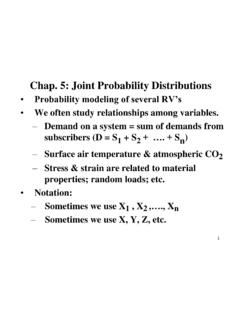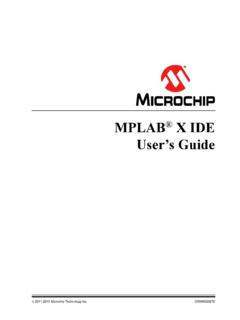Transcription of Chap 3 : Organizational Structure
1 1 Anne Drumaux Management OrganizationSolvay Business School1 chap 3 : Organizational Structure Organization versus Structure Theories of contingency approach Internal and external factors a typology of organizations (Mintzberg) Types of Organizational structures functional organization (U-form) divisional organization (M-form, H-form) matrix organization (matrix-form) network organization composite Structure examples formal and informal structureAnne Drumaux Management OrganizationSolvay Business School2 ENVIRONMENTC ultureSocial structurePhysical structureTechnologyORGFive circles model(Hatch, 1997)2 Anne Drumaux Management OrganizationSolvay Business School3 Chronology of Organizational theories (SCOTT)Organization is a closed systemOrganization is an open systemIndividual is a rational agentIndividual is a social agent1900 1900 --193019301960 1960 --197019701930 1930 --196019601970 1970 for efficient productionAdapt structureIndividual motivationMobilize through cultureDirective Management Contingency and planificationHuman RelationsParticipating management Order from rules Organization modeled by exogenous forces role of group and working conditions Complexity, change, turbulence and adhocracy Max WEBER(1864-1920)Frederick TAYLOR (1856-1915)Henri FAYOL (1841-1925)
2 Alfred CHANDLERPaul LAWRENCE et Jay LORSCHJ ohan WOODWARDC harles PERROWE lton MAYOD ouglas McGREGORA braham MASLOWF rederick HERZBERGKarl WEICKJ ames MARCHW illiam OUCHIH erbert SIMONM ichel CROZIERAnne Drumaux Management OrganizationSolvay Business School4 Definitions organizationis a pattern of relationships through which people, under the direction of managers, pursue their common goals Organizational structureis the way in which organization s activities are divided, organized and coordinated3 Anne Drumaux Management OrganizationSolvay Business School5 Theories of contingency approachOrganizational structures are influenced by Organizational structures are influenced by Internal VariablesExternal Variables(environment)agesizetechnologys trategyvariabilityturbulencerelativityna tional culturecoordinationLabor divisionStarbuck, Greiner, StinchcombeDale, Blau, AldrichWoodward, PerrowChandler, ChildBurns et StalkerEmery et TristLaurence et LorschHofstedeMintzbergAnne Drumaux Management OrganizationSolvay Business School6 ChandlerField unitGeographic expansionUnit firmVertical integrationFunctional evoluated organizationMultidivisional firmDiversificationStructure has tomatch strategy4 Anne Drumaux Management OrganizationSolvay Business School7 Environment s factors Burns and Stalker The Mechanistic Organization The Organic Organization Lawrence and Lorsch Differentiation and Integration Three sub-environments Anne Drumaux Management OrganizationSolvay Business School8 Organization Environment1.
3 Changes in Demand 2 Changes in the nature of technological innovation and new product development (R&D)4. Quickly evolving government policies1. Stable Demand2 Unchanged set of competitors3. Evolutionary technological innovation and new product developments .4. Government policies change little over timeDynamicStable5 Anne Drumaux Management OrganizationSolvay Business School9 Burns and Stalker coordination of tasks to achieve a common goal continuous re-definition of responsibilities lateral flow of knowledge knowledge dictate authority center information and advice prestige due to expertise specialization and fragmentation of tasks hierarchic Structure of control knowledge vertical flow through hierarchy loyalty and obedience to the superior instructions and decisions prestige due to job titlesOrganic -FLUIDM echanistic -RIGIDAnne Drumaux Management OrganizationSolvay Business School10 Mechanistic and Organic OrganizationSpecialization&Tall HierarchyCentralized Decision MakingKnowledge at the top of the pyramidEmployees procedure orientedFlat structureDecentralized decision makingKnowledge locates
4 EverywherePeople goal oriented6 Anne Drumaux Management OrganizationSolvay Business School11 Lawrence and Lorsch (1969) Differentiation Different Organizational functions deal with distinct segments of environment People in different functions develop unique perspectives and orientations Integration Functional activities are coordinated and controlled to achieve goals of organization Vertical and horizontal coordinationAnne Drumaux Management OrganizationSolvay Business School12 Sub-Environment The market sub-environment-- Marketing function The technical-economic sub-environment-- Production function The scientific sub-environment-- Research and Development7 Anne Drumaux Management OrganizationSolvay Business School13 Functional Sub- Structure ProductionShort time horizon, stable environment, rules and procedures Research and development Long time horizon, unstable situation.
5 Fluid and organic MarketingBetween these two extremesAnne Drumaux Management OrganizationSolvay Business School14 Comparative StudyRules and centralized decision makingLowStableContainersIndustryRules and centralized decision making; Lateral integration sometimes can be foundMediumMediumConsumerFoodIndustryPer manent lateral integration mechanismHighDynamicPlasticsIndustryInte grationDifferentiationEnviron-ment8 Anne Drumaux Management OrganizationSolvay Business School15WS2 Contingency FactorsQuestions on contingency factors How old is your organization? What is its size? How could you characterize technologies used? What is the status of the environment (stable or unstable, rate of change)? What are the nature of the tasks (repetitive or differentiated)? How would define the division of labor? (specialization into single tasks, differentiated tasks) How would describe the ways the members of your organization coordinate their respective tasks?
6 How activities of each members are integrated to produce common goals?Anne Drumaux Management OrganizationSolvay Business School16 Questions on internal dynamics between members Could you define different types of staff and personnel inside the organization? What are their main role regarding the organization? Taking into account difference between formal authority, power and leadership, would you consider that specific groups of staffor personnel are in a better position regarding the whole organization? Are they in position to impose their views? On which matters? Do conflicts or potential conflicts exist ? On which? What are the most frequent type of conflicts? How are they solved? Which groups are concerned? 9 Anne Drumaux Management OrganizationSolvay Business School17 Mintzberg H.(1939-)The Structuring of Organizations 1979 Power in and around Organizations 1983ways of coordination mutual adjustment direct supervision process standardization results standardization competences standardizationAnne Drumaux Management OrganizationSolvay Business School18 Simple structureMechanisticBureaucracy10 Anne Drumaux Management OrganizationSolvay Business School19 ProfessionalBureaucracyMultidivisionform Anne Drumaux Management OrganizationSolvay Business School20 Adhocracy11 Anne Drumaux Management OrganizationSolvay Business School21 Strategic ApexMiddlelineSupport staffTechnostructureOperating coreAnne Drumaux Management OrganizationSolvay Business School22 CentralizationOver-standardizationSuppor t negotiationProfessionnalisation Balkanisation 12 Anne Drumaux Management OrganizationSolvay Business School23 Types of Organizational structures
7 Functional organization (U-form) divisional organization (M-form, H-form) matrix organization (matrix-form) network organization composite Structure examples formal and informal structureAnne Drumaux Management OrganizationSolvay Business School24 General managerPurchasingEngineeringManufacturin gSalesAccountingAn Organizational chart showing a functional structure13 Anne Drumaux Management OrganizationSolvay Business School25 Evoluated U-formCEOR esearchControlMarketingFinanceHuman ResourcesProductionCommercialPurchasingP roductionResearchplant Aplant BExportSalesSales administrationZone 1 Zone 2 Anne Drumaux Management OrganizationSolvay Business School26 Functional Structure (U-Form) : advantages & defaultsA+efficiency if environnemental stability and stable technologycareer plans policy in each functionbest specialists at the top of each functionD-over-centralization due to the General Direction or/and its staffno mobility regarding technologybest solution once given a technology14 Anne Drumaux Management OrganizationSolvay Business School27 General managerCEOD ivision BDivision ADivision CENGMKGFINSALESENGMKGSALESFINENGMKGSALES FINAn Organizational chart showing a multi-divisional structureAnne Drumaux Management OrganizationSolvay Business School28 Product M-formCEOR&DMarketingproductionFinancePh armaceutical productsHospital productsPersonal-care productsMarket M-formCEOM arketingproductionfinancehuman ResourcesLatin America and Far EastNorth AmericaEurope.
8 Africa and Midle East15 Anne Drumaux Management OrganizationSolvay Business School29H-form as specific case of multidivisional foodpacking glasstransportDry productsFresh & joint productsbakery productsAnne Drumaux Management OrganizationSolvay Business School30 Divisional Structure (M-Form and H-form) : advantages & defaultsA+based on strategic segmentation : it allows assessment enterprise position in relation to its marketconstructed as profit centers : it allows accountability and responsibility in each centercontrol on same criteriaemergence of generalist senior executives permits :strategy definition in each segment leaving global strategy to top managementduplication of general direction16 Anne Drumaux Management OrganizationSolvay Business School31D-no scale economies :organization aimed at optimization at the level of the division onlyno easy transmission of technical competences : dispersion of specialists in the structurecomplex to manage when interdependency between divisions growsAnne Drumaux Management OrganizationSolvay Business School32 General managerENGMFGSALESACCTGP roject AProject BProject CProject Members drawn from functionsAn Organizational chart showing a matrix structure17 Anne Drumaux Management OrganizationSolvay Business School34 Exec committeeAsiaNorth AmericaECEastern EuropeProduct group AProductgroup BProductgroup CLocalfirmsThe global matrixAnne Drumaux Management OrganizationSolvay Business School35 Matrix Structure (Matrix-Form).
9 Advantages & defaultsA+double coordination on functions and products or marketsvertical coordination allows efficiency in each functionhorizontal coordination allows effectiveness for each product or marketavoids defaults of U-form and M-formbreak the old principles ( unity of command, unity of direction)insists on collective performance more than on individual performanceintroduce some plasticity in the Structure 18 Anne Drumaux Management OrganizationSolvay Business School36D-efficiency and effectiveness linked to the acceptance of multiple managementnew rules are long to implement necessity of arbitrage supremacy stake between functional and divisional departmentsif strong conflict, danger of overflow at direction levelhuge cultural shockAnne Drumaux Management OrganizationSolvay Business School37 Network Structure Relatively new Replaces vertical communication and control with lateral relationships Appear when rapid technological changes, shortened product life cycle, fragmented markets Result of outsourcing or collaboration Limit.
10 Virtual organization19 Anne Drumaux Management OrganizationSolvay Business School38 SpiderToyota and subcontractorsAnne Drumaux Management OrganizationSolvay Business School39 HubDellBenetton20 Anne Drumaux Management OrganizationSolvay Business School40 WebAnne Drumaux Management OrganizationSolvay Business School41 Network Structure : avantages & disavantagesA+- Allows rapid growth-Flexible- Efficient if control (Ouchi : market, bureaucracy, clan)- Common brandingD-- Rapid decline too- Danger if loss of control- Common image may be difficult to share21 Anne Drumaux Management OrganizationSolvay Business School42 Composit structuresexisting structures under specific conditionsinternal growthpartial diversificationprocess of international expansionAnne Drumaux Management OrganizationSolvay Business School43U-Form internationalizationCEOD irection subsidiary 1 Direction subsidiary 2 ProductionSalesExportFinanceM-form internationalizationCEOD irection subsidiary 1 Direction subsidiary 2 Division product ADivision product BDivision product C22 Anne Drumaux Management OrganizationSolvay Business School44 Matrix-form internationalizationProduct strategy dominantCEOD ivisionproduct ADivisionproduct BDomesticInternationalInternational DivisionZone XZone YSubsidiarycountry 1 Subsidiarycountry 2product Drumaux









